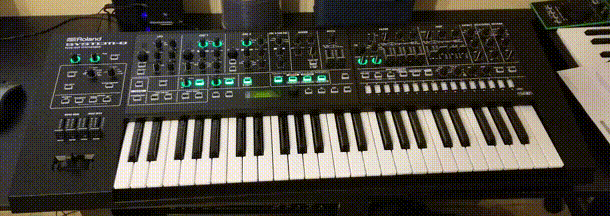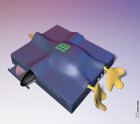My Roland System-8

Introduction
After buying a Roland System-1, I started wanting a larger keyboard with even more features. Subscribing to Roland Cloud, I fell in love with the Jupiter-8 and Juno-106 Plug-Outs. I thought to myself, it's time to get a larger synthesizer with the features I like. So it was only logical that I would eventually buy a System-8.I am very happy with my purchase. This is a fantastic synthesizer.
If you only want my patch banks, click the donate page to download them.
To read my blog about the System-8, click here.
Review
Unboxing
The System-8 came with a more substantial owner's manual than the System-1, but it still wasnt as complete as it shouldve been. The System-8 also doesn't come with a vocoder microphone, for example.It also didnt come with the most recent software, but updating it was easy. However, the manual doesn't tell me how to use the bandpass filter section (filter section in variation 2) so I'm still trying to figure that out.
Appearance
This thing looks fantastic! Very
polished and professional looking. Unlike the System-1, it
seems to have a few less back-lit controls, but not in a bad
way. It wasn't very hard to navigate the controls.
And having LCD screens makes figuring out what's going on a
whole lot easier.
As well, you can get side protectors for the
System-8. I chose the brushed aluminum side protectors,
and I love it!
Feel
This is my first keyboard, so the
non-weighted keyboard is quite new to me (but it's not like a
"controller" keyboard like the System-1). I've been
getting used to playing with the velocity sensitivity at max for
all patches, which is much more convenient during live music
(i.e. rather than reaching over for the volume knob).
The other controls feel great as well.
The sole modulation lever (for pitch bend and modulation) didn't
take long to get used to. I mapped all my patches so that
left and right is a filter sweep, which works great in church.
The interesting way in which patches are
selected and saved is worth noting. You select them by
letter and number (so you have 16 buttons towards the right
side). You can also select them by the central "value
knob," which is helpful. And the LCD screen displays which
preset you're on. However, unlike the System-1's very
convenient save feature (hold the button), at first I thought
you had to press "write" four times to save patches. But then I
found a shortcut: shift+write will save after you press enter
once.
Features
There are tons of features here to talk about.
First, there's performance mode. At
first, I was frustrated with this mode, because even though it's
cool, I couldn't get the patches to "stay" on their side of the
keyboard. All button presses registered in both
parts. This was echoed by the Facebook
System-8 User Group, who wished for an actual "Keyboard
Split" button. However, then I learned how to edit patches
so that I told the patches where on the keyboard to
respond. Ultimately this was much better, because you have
control over their range.
You can find a list of the factory
performance mode mappings, for reference use, here.
Initial Sounds
The initial sounds are good, and useful for church. I previewed the many sounds available for the System-8 using the VST, and using the System-8 in real life was even better than using the VST. I have also reviewed the other Plug-Outs here.When I got it, it included two Plug-Outs (the Jupiter-8 and Juno-106) and was using software version 1.12. I updated it via Roland to 1.3 when I got it, which was a pretty easy process. Version 1.3 comes with the JX-3P Plug-Out for slot 3, basically making the System-8 a four synthesizer juggernaut. But now there's also the Juno-60, available on Roland Cloud!
Using It In Church
The System-8 works very well in church! There are no danger buttons to accidentally push. Not only do the patches work well in a worship environment, but the ability to split the keyboard in Performance Mode makes it very useful. And to top it off, you can use each Plug-Out for what some people claim they are best at (Jupiter-8 for strings, Juno-106 for pads, etc).
Having the Plug-Outs available only increases the usefulness of the System-8, as now the player has more presets to call upon. This leads to many possibilities, such as (for example) loading one Plug-Out with only leads, pads, or some other type of patches. As well, having more patches gives the player more options to choose from. And if thats not enough for the user, other Plug-Outs via the Roland Cloud (System-100, Pro Mars, etc) only make it even more flexible. One could include some iconic leads and/or basses from the Pro Mars and/or SH-101 and/or SH-2 and use them in split keyboard modes, if desired.
The Line In function is also helpful for
those who want to run another instrument. For example,
Ive used it in church for running my System-1 so that I can
reach over and use it for timpani. (I could Plug-Out the
ProMars into the System-8, but then I would lose whatever
plug-out was in that slot.) However, I found that a better
way to run things in church is using a mixer. That way you
still have the Line In port for a microphone for the vocoder if
you need it.
For example, one time my worship leader called upon me to play bass, since (due to COVID19) we had only 5 people on the worship team. I tried to use a few of the included bass sounds (both System-8 and the various PLUG-OUTs) that I had included in my patch line-up. The worship leader didn't like them as much, so he asked me to synthesize one in the moment. So I did, and he was able to tell me (since he is standing on the other side of the platform) what it sounds like to him. He is listening to the bass subwoofer and house speakers. Between the two of us, we found a sound that sounds great and also sounds good through our house mix. Ironically, he wanted more ultra-low-end thump and presence. It worked, and I saved it all to my System-8. It took only five minutes. With a synthesizer, you don't just play sounds (like on a keyboard): you can shape sounds.
NEW! I have
begun using the Sequencer in church and I'm happy to say it
works with my worship leader's Macbook Pro running Ableton for
tracks. I have put the instructions on my System-8
Blog.
Synthesizing Sounds
Synthesizing sounds on the System-8 is pretty easy. The only difficulty Ive encountered stems from how many controls there are rather than any lack of capability: you can tweak your sound for hours if you accidentally get a bit carried away!As usual, to make the System-8s patches useful for church, where appropriate Ive needed to change attack time, filter parameters, reduce delays, and reconfigure the mod lever. On most patches except leads, I prefer the mod lever left/right to control the filter (which is useful in church) and forward (bend) to control vibrato. With other patches, I have modified the amp section velocity sensitivity enough that the volume increases when I increase key press velocity, so that it follows my natural playing. With mainly the piano-like patches, I have added or adjusted filter velocity sensitivity to make it sound more natural, just like hitting the keys harder on a real piano results in a slightly brighter note.
Conclusion
Please see my System-8 Blog for more things I learn!
The System-8 is an excellent synthesizer. In my opinion, there's no need to buy an expensive Nord keyboard for your church. Really, with the System-8 you can go without Ableton patches, also, if you either use one of the 2,000+ patches that's closest to what you want, or learn to synthesizer your own.
Hopefully churches will realize just how
awesome the System-8 is and buy them rather than more expensive
instruments.




